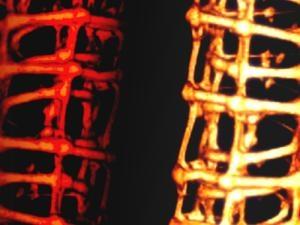Scientists at Harvard University are working on rat cardiomyocytes, but slightly different than most scientists. They're snaking them through wires and transistors that peer into each cell's electrical impulses. In the future, these wires might actually control their behavior, too.

"Cyborg" tissues have been created for neurons, muscle and vessels, and could be used to test drugs, or used as the basis for biological versions of existing implants. If signals can eventually be sent to the cells, cyborg tissues could eventually be used to create tiny robots, or get used in prosthetics. Charles Lieber, who leads the cyborg tissue team, has said:
It allows one to effectively blur the boundary between electronic, inorganic systems and organic, biological ones.
Artificial cells can already be grown on three-dimensional scaffolds that are made up of biological materials, but are not electrically active. Electrical components need to be added to cultured tissue before, but not integrated into its structure, so they were only able to scrap information from the surface. Lieber's team combined these strands of work, and created an electrically active scaffold. 3D networks were then created using conductive nanowires studded with silicon sensors.
The wires, at the scale they were at, had to be very flexible in order to not interfere with the growth of tissue. Lieber's team did achieve something that had previously not been done before, by growing an entire blood vessel approximately 1.5cm long from human cells, with wires snaked through it, and recorded electrical signals from inside and outside the vessel. Lieber's team were able to detect electrical patterns that could give clues to inflammation, changes in tissue that could make it prone to tumour formation, or impending heart disease.
Leiber's colleague, Daniel Kohane, says:
You could use these things to directly measure the effects of drugs in synthetically grown human tissue without ever having to test them in an actual human being.
It's an incredible exciting time to be alive, isn't it?

